service CADILLAC XT5 2020 Owners Manual
[x] Cancel search | Manufacturer: CADILLAC, Model Year: 2020, Model line: XT5, Model: CADILLAC XT5 2020Pages: 384, PDF Size: 6.52 MB
Page 338 of 384
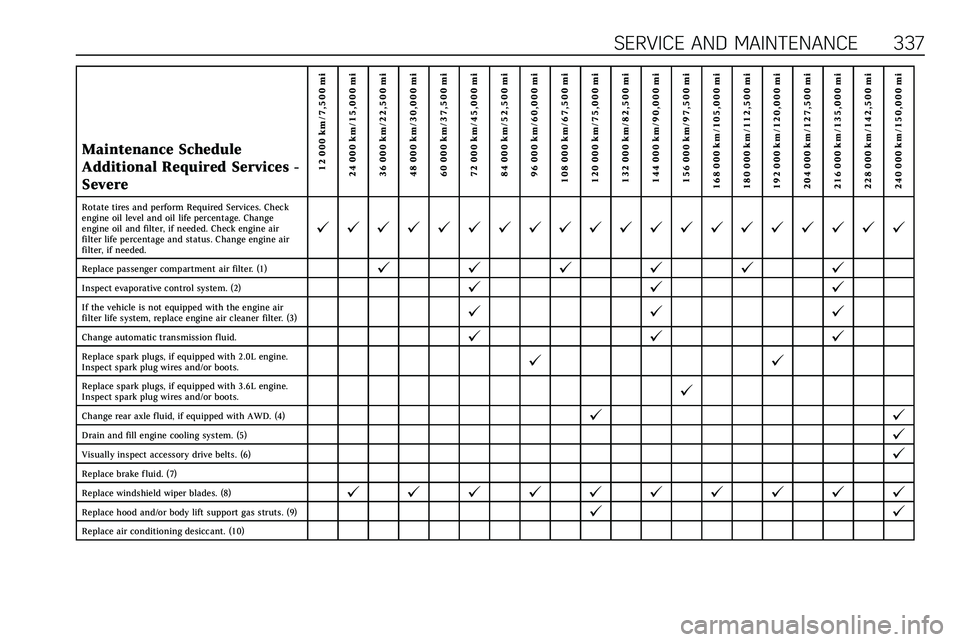
SERVICE AND MAINTENANCE 337
Maintenance Schedule
Additional Required Services -
Severe12 000 km/7,500 mi
24 000 km/15,000 mi
36 000 km/22,500 mi
48 000 km/30,000 mi
60 000 km/37,500 mi
72 000 km/45,000 mi
84 000 km/52,500 mi
96 000 km/60,000 mi
108 000 km/67,500 mi
120 000 km/75,000 mi
132 000 km/82,500 mi
144 000 km/90,000 mi
156 000 km/97,500 mi
168 000 km/105,000 mi
180 000 km/112,500 mi
192 000 km/120,000 mi
204 000 km/127,500 mi
216 000 km/135,000 mi
228 000 km/142,500 mi
240 000 km/150,000 mi
Rotate tires and perform Required Services. Check
engine oil level and oil life percentage. Change
engine oil and filter, if needed. Check engine air
filter life percentage and status. Change engine air
filter, if needed.
@ @ @ @ @ @ @ @ @ @ @ @ @ @ @ @ @ @ @ @
Replace passenger compartment air filter. (1)@ @@@@@
Inspect evaporative control system. (2)@ @@
If the vehicle is not equipped with the engine air
filter life system, replace engine air cleaner filter. (3)@@@
Change automatic transmission fluid.@@@
Replace spark plugs, if equipped with 2.0L engine.
Inspect spark plug wires and/or boots.@ @
Replace spark plugs, if equipped with 3.6L engine.
Inspect spark plug wires and/or boots.@
Change rear axle fluid, if equipped with AWD. (4)@ @
Drain and fill engine cooling system. (5)@
Visually inspect accessory drive belts. (6)@
Replace brake fluid. (7)
Replace windshield wiper blades. (8)
@ @ @ @ @ @ @ @ @ @
Replace hood and/or body lift support gas struts. (9)@@
Replace air conditioning desiccant. (10)
Page 339 of 384

338 SERVICE AND MAINTENANCE
Footnotes—Maintenance Schedule
Additional Required Services -
Severe
(1) Or every two years, whichever
comes first. More frequent passenger
compartment air filter replacement
may be needed if driving in areas with
heavy traffic, poor air quality, high
dust levels, or environmental
allergens. Passenger compartment air
filter replacement may also be needed
if there is reduced airf low, window
fogging, or odors. Your GM dealer can
help determine when to replace the
filter.
(2) Visually check all fuel and vapor
lines and hoses for proper attachment,
connection, routing, and condition.
(3) Or every four years, whichever
comes first. If driving in dusty
conditions, inspect the filter at each
oil change or more often as needed.
See Engine Air Cleaner/Filter 0259.
(4) Do not directly power wash the
transfer case and/or front/rear axle
output seals. High pressure water can
overcome the seals and contaminate
the transfer case fluid. Contaminated fluid will decrease the life of the
transfer case and/or axles and should
be replaced.
(5)
Or every five years, whichever
comes first. See Cooling System0260.
(6) Or every 10 years, whichever
comes first. Inspect for fraying,
excessive cracking, or damage; replace,
if needed.
(7) Replace brake fluid every five
years. See Brake Fluid 0267.
(8) Or every 12 months, whichever
comes first. See Wiper Blade
Replacement 0270.
(9) Or every 10 years, whichever
comes first. See Gas Strut(s)0271.
(10) Replace air conditioning
desiccant every seven years.Special Application
Services
. Severe Commercial Use Vehicles
Only: Lubricate chassis
components every oil change.
. Have underbody flushing service
performed. See "Underbody
Maintenance" in Exterior Care
0 323.
Page 340 of 384
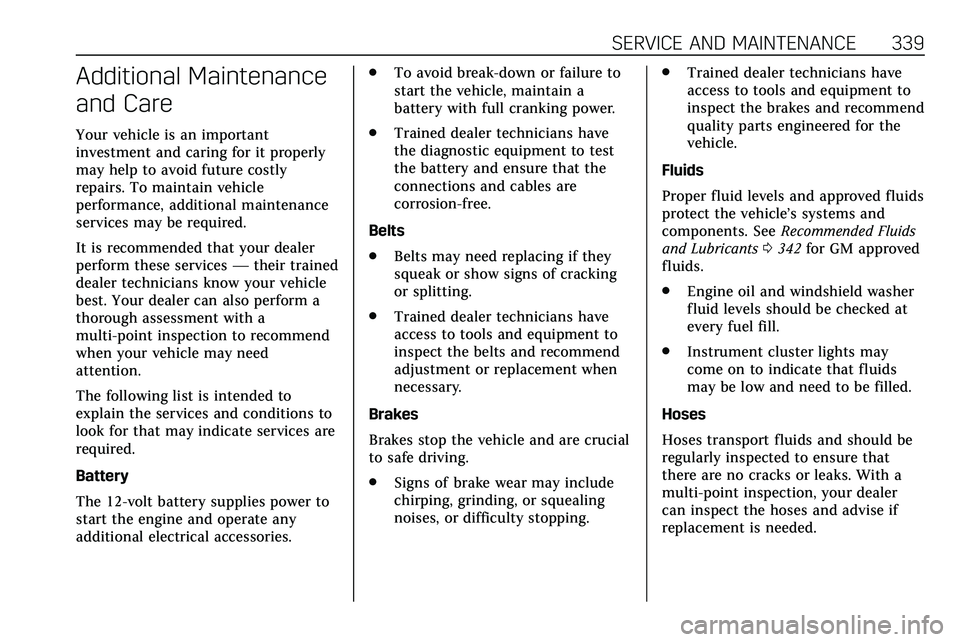
SERVICE AND MAINTENANCE 339
Additional Maintenance
and Care
Your vehicle is an important
investment and caring for it properly
may help to avoid future costly
repairs. To maintain vehicle
performance, additional maintenance
services may be required.
It is recommended that your dealer
perform these services—their trained
dealer technicians know your vehicle
best. Your dealer can also perform a
thorough assessment with a
multi-point inspection to recommend
when your vehicle may need
attention.
The following list is intended to
explain the services and conditions to
look for that may indicate services are
required.
Battery
The 12-volt battery supplies power to
start the engine and operate any
additional electrical accessories. .
To avoid break-down or failure to
start the vehicle, maintain a
battery with full cranking power.
. Trained dealer technicians have
the diagnostic equipment to test
the battery and ensure that the
connections and cables are
corrosion-free.
Belts
. Belts may need replacing if they
squeak or show signs of cracking
or splitting.
. Trained dealer technicians have
access to tools and equipment to
inspect the belts and recommend
adjustment or replacement when
necessary.
Brakes
Brakes stop the vehicle and are crucial
to safe driving.
. Signs of brake wear may include
chirping, grinding, or squealing
noises, or difficulty stopping. .
Trained dealer technicians have
access to tools and equipment to
inspect the brakes and recommend
quality parts engineered for the
vehicle.
Fluids
Proper fluid levels and approved fluids
protect the vehicle’s systems and
components. See Recommended Fluids
and Lubricants 0342 for GM approved
fluids.
. Engine oil and windshield washer
fluid levels should be checked at
every fuel fill.
. Instrument cluster lights may
come on to indicate that fluids
may be low and need to be filled.
Hoses
Hoses transport fluids and should be
regularly inspected to ensure that
there are no cracks or leaks. With a
multi-point inspection, your dealer
can inspect the hoses and advise if
replacement is needed.
Page 341 of 384

340 SERVICE AND MAINTENANCE
Lamps
Properly working headlamps,
taillamps, and brake lamps are
important to see and be seen on
the road.
.Signs that the headlamps need
attention include dimming, failure
to light, cracking, or damage. The
brake lamps need to be checked
periodically to ensure that they
light when braking.
. With a multi-point inspection,
your dealer can check the lamps
and note any concerns.
Shocks and Struts
Shocks and struts help aid in control
for a smoother ride.
. Signs of wear may include steering
wheel vibration, bounce/sway
while braking, longer stopping
distance, or uneven tire wear.
. As part of the multi-point
inspection, trained dealer
technicians can visually inspect
the shocks and struts for signs of leaking, blown seals, or damage,
and can advise when service is
needed.
Tires
Tires need to be properly inflated,
rotated, and balanced. Maintaining
the tires can save money and fuel, and
can reduce the risk of tire failure.
. Signs that the tires need to be
replaced include three or more
visible treadwear indicators; cord
or fabric showing through the
rubber; cracks or cuts in the tread
or sidewall; or a bulge or split in
the tire.
. Trained dealer technicians can
inspect and recommend the right
tires. Your dealer can also provide
tire/wheel balancing services to
ensure smooth vehicle operation
at all speeds. Your dealer sells and
services name brand tires.
Vehicle Care
To help keep the vehicle looking like
new, vehicle care products are
available from your dealer. For
information on how to clean and protect the vehicle’s interior and
exterior, see
Interior Care 0327 and
Exterior Care 0323.
Wheel Alignment
Wheel alignment is critical for
ensuring that the tires deliver optimal
wear and performance.
. Signs that the alignment may need
to be adjusted include pulling,
improper vehicle handling,
or unusual tire wear.
. Your dealer has the required
equipment to ensure proper wheel
alignment.
Windshield
For safety, appearance, and the best
viewing, keep the windshield clean
and clear.
. Signs of damage include scratches,
cracks, and chips.
. Trained dealer technicians can
inspect the windshield and
recommend proper replacement if
needed.
Page 342 of 384
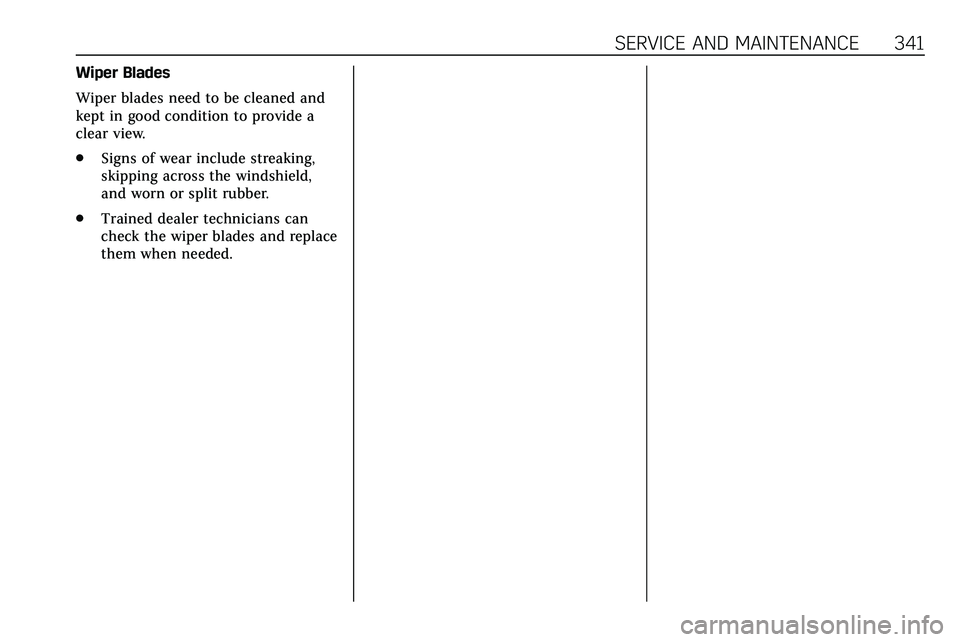
SERVICE AND MAINTENANCE 341
Wiper Blades
Wiper blades need to be cleaned and
kept in good condition to provide a
clear view.
.Signs of wear include streaking,
skipping across the windshield,
and worn or split rubber.
. Trained dealer technicians can
check the wiper blades and replace
them when needed.
Page 343 of 384
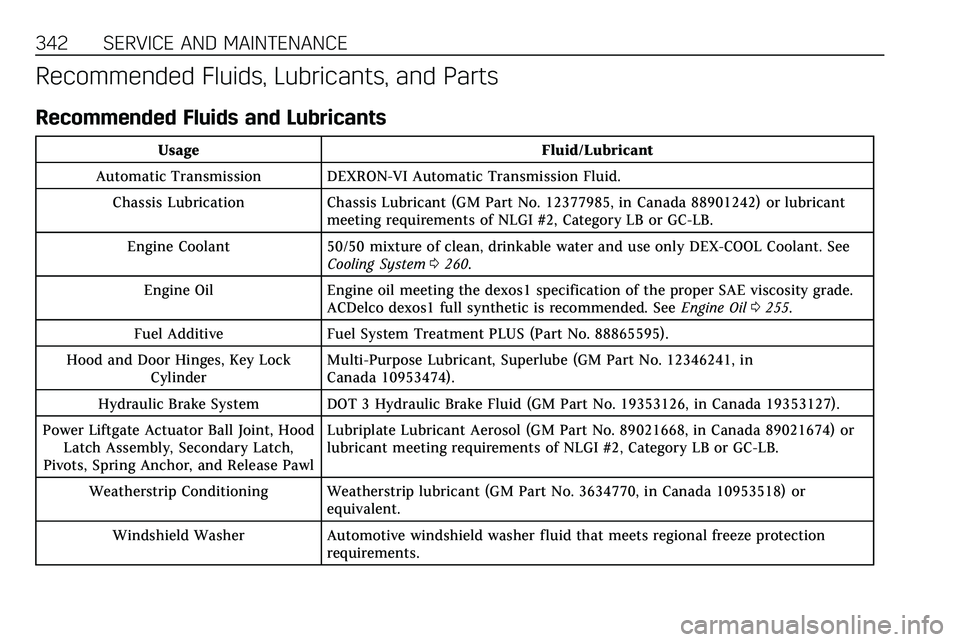
342 SERVICE AND MAINTENANCE
Recommended Fluids, Lubricants, and Parts
Recommended Fluids and Lubricants
UsageFluid/Lubricant
Automatic Transmission DEXRON-VI Automatic Transmission Fluid. Chassis Lubrication Chassis Lubricant (GM Part No. 12377985, in Canada 88901242) or lubricant
meeting requirements of NLGI #2, Category LB or GC-LB.
Engine Coolant 50/50 mixture of clean, drinkable water and use only DEX-COOL Coolant. See
Cooling System 0260.
Engine Oil Engine oil meeting the dexos1 specification of the proper SAE viscosity grade.
ACDelco dexos1 full synthetic is recommended. See Engine Oil0255.
Fuel Additive Fuel System Treatment PLUS (Part No. 88865595).
Hood and Door Hinges, Key Lock Cylinder Multi-Purpose Lubricant, Superlube (GM Part No. 12346241, in
Canada 10953474).
Hydraulic Brake System DOT 3 Hydraulic Brake Fluid (GM Part No. 19353126, in Canada 19353127).
Power Liftgate Actuator Ball Joint, Hood Latch Assembly, Secondary Latch,
Pivots, Spring Anchor, and Release Pawl Lubriplate Lubricant Aerosol (GM Part No. 89021668, in Canada 89021674) or
lubricant meeting requirements of NLGI #2, Category LB or GC-LB.
Weatherstrip Conditioning Weatherstrip lubricant (GM Part No. 3634770, in Canada 10953518) or equivalent.
Windshield Washer Automotive windshield washer fluid that meets regional freeze protection
requirements.
Page 344 of 384
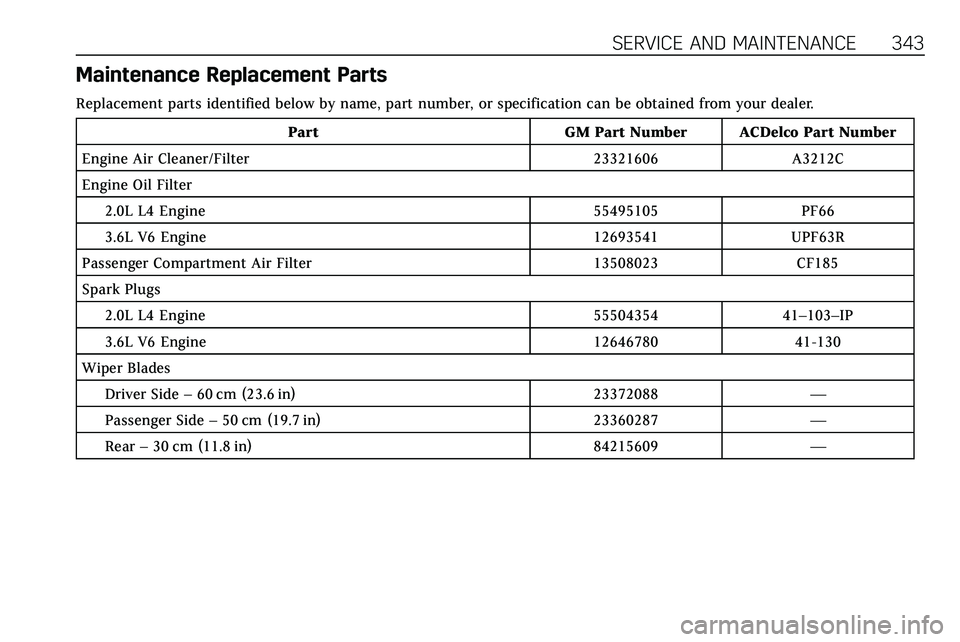
SERVICE AND MAINTENANCE 343
Maintenance Replacement Parts
Replacement parts identified below by name, part number, or specification can be obtained from your dealer.Part GM Part Number ACDelco Part Number
Engine Air Cleaner/Filter 23321606 A3212C
Engine Oil Filter 2.0L L4 Engine 55495105 PF66
3.6L V6 Engine 12693541 UPF63R
Passenger Compartment Air Filter 13508023 CF185
Spark Plugs 2.0L L4 Engine 55504354 41–103–IP
3.6L V6 Engine 12646780 41-130
Wiper Blades Driver Side –60 cm (23.6 in) 23372088 —
Passenger Side –50 cm (19.7 in) 23360287 —
Rear –30 cm (11.8 in) 84215609 —
Page 345 of 384

344 SERVICE AND MAINTENANCE
Maintenance Records
After the scheduled services are performed, record the date, odometer reading, who performed the service, and the type of
services performed in the boxes provided. Retain all maintenance receipts.Date Odometer
Reading Serviced By Maintenance Stamp Services Performed
Page 346 of 384

TECHNICAL DATA 345
Technical Data
Vehicle Identification
Vehicle IdentificationNumber (VIN) . . . . . . . . . . . . . . . . . . . 345
Service Parts Identification . . . . . . 345
Vehicle Data
Capacities and Specifications . . . . 346
Engine Drive Belt Routing . . . . . . . 348
Vehicle Identification
Vehicle Identification
Number (VIN)
This legal identifier is in the front
corner of the instrument panel, on the
driver side of the vehicle. It can be
seen through the windshield from
outside. The Vehicle Identification
Number (VIN) also appears on the
Vehicle Certification and Service Parts
labels and certificates of title and
registration.
Engine Identification
The eighth character in the VIN is the
engine code. This code identifies the
vehicle's engine, specifications, and
replacement parts. See “EngineSpecifications”
underCapacities and
Specifications 0346 for the vehicle's
engine code.
Service Parts Identification
There may be a large barcode on the
certification label on the center pillar
that you can scan for the following
information:
. Vehicle Identification
Number (VIN)
. Model designation
. Paint information
. Production options
If there is not a large barcode on this
label, then you will find this same
information on a label under the load
floor, inside the cargo storage
shelf unit.
Page 350 of 384

CUSTOMER INFORMATION 349
Customer
Information
Customer Information
Customer SatisfactionProcedure . . . . . . . . . . . . . . . . . . . . . . . 349
Customer Assistance Offices . . . . 351
Customer Assistance for Text Telephone (TTY) Users . . . . . . . . . 351
Online Owner Center . . . . . . . . . . . . . 352
GM Mobility Reimbursement Program . . . . . . . . . . . . . . . . . . . . . . . . . 352
Roadside Service . . . . . . . . . . . . . . . . . 353
Scheduling Service Appointments . . . . . . . . . . . . . . . . . . . 354
Courtesy Transportation Program . . . . . . . . . . . . . . . . . . . . . . . . . 355
Collision Damage Repair . . . . . . . . . 356
Publication Ordering Information . . . . . . . . . . . . . . . . . . . . . 358
Radio Frequency Statement . . . . . 358
Reporting Safety Defects
Reporting Safety Defects to the United States Government . . . . . 359
Reporting Safety Defects to the Canadian Government . . . . . . . . . 359 Reporting Safety Defects to
General Motors . . . . . . . . . . . . . . . . . 360
Vehicle Data Recording and
Privacy
Vehicle Data Recording andPrivacy . . . . . . . . . . . . . . . . . . . . . . . . . . . 360
Cybersecurity . . . . . . . . . . . . . . . . . . . . . 360
Event Data Recorders . . . . . . . . . . . . 361
OnStar . . . . . . . . . . . . . . . . . . . . . . . . . . . . . 362
Infotainment System . . . . . . . . . . . . . 362
Customer Information
Customer Satisfaction
Procedure
Your satisfaction and goodwill are
important to your dealer and to
Cadillac. Normally, any concerns with
the sales transaction or the operation
of the vehicle will be resolved by your
dealer's sales or service departments.
Sometimes, however, despite the best
intentions of all concerned,
misunderstandings can occur. If your
concern has not been resolved to your
satisfaction, the following steps
should be taken:
STEP ONE : Discuss your concern
with a member of dealership
management. Normally, concerns can
be quickly resolved at that level. If the
matter has already been reviewed with
the sales, service or parts manager,
contact the owner of your dealership
or the general manager.
STEP TWO : If after contacting a
member of dealership management, it
appears your concern cannot be
resolved by your dealership without